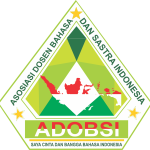FUNGSI SINTAKSIS FRASA NOMINA DALAM CERKAK “PESUGIHAN KANDHANG BUBRAH” KARYA JMV SUNARDJO PADA RUBRIK ALAMING LELEMBUT MAJALAH PANJEBAR SEMANGAT
Abstract
Phrases in Javanese are usually composed of two or more words as members. Nominal phrase is a type of phrase that contains the essence of a noun in its constituent elements and can act as a substitute for a noun. Syntax functions related to words or phrases in a sentence consist of subject, predicate, object, complement, description. This study aims to describe the forms and characteristics of the nominal phrase functions contained in the magazine Panjebar Semangat number 52, 26 December 2020 edition. The research method used is descriptive qualitative. The data presented is in the form of a verbal word in the form of a sentence in which there are noun phrases. Sources of data in this study are documents or written data in the form of a softening rubric in Panjebar Semangat magazine number 52 December 26, 2020 edition. Data collection methods in this study are observation and note-taking techniques. The main instrument in this study is the researcher himself (human instrument). The method of data analysis in this research is a separate method using the basic technique for the direct elements (BUL). This study uses triangulation that utilizes theory, namely checking using syntactic theory books. The results of the research are the forms and functions of noun phrases in Panjebar Semangat magazine number 52 December 26, 2020 edition consisting of 3 forms and functions of noun phrases consisting of noun + noun with the findings of the noun phrases bongkotan pring (S) and wooden fork (O), noun + verb, there are findings of my semedic room that occupy the complement (Pel), noun + adjective, there is a finding that the little one occupies the subject (S).
Keywords
Full Text:
PDFReferences
Aditiawan, R.T. (2020). Penggunaan frasa nomina dalam surat kabar Jawa Pos: kontruksi frasa nomina. Jurnal Belajar Bahasa, 5(2), 221-232.
Apriani, N.K. (2015). Frasa nomina Jawa Kuna dalam Teks Adiparwa. Jurnal HUMANIS, 13(2), 1-8.
Brown, H. D. (2001). Teaching by principles: an interactive approach to language pedagogy. New York: Addison Wesley Longman, Inc.
Chaer, A. (2009). Sintaksis Bahasa Indonesia: pendekatan proses. Jakarta: Rineka Cipta.
Kinanti, K.P. (2020). Frasa nominal atributif dalam bahasa jawa dialek Jawa Timur. Jurnal Linguista: Jurnal Ilmiah Bahasa, Sastra, dan Pembelajarannya, 4(2), 95-104. DOI: http://doi.org/10.25273/linguista.v4i2.6494
Kridalaksana, H. (1984). Kamus linguistik. Jakarta: Gramedia.
Mayasari, D., & Ardhana, N.R. (2018). Publikasi bentuk fungsi dan kategori sintaksis tuturan masyarakat Manduro sebagai pendukung perkembangan bahasa anak usia dini. Jurnal OBSESI, 2(1), 54-63. DOI: 10.31004/obsesi.v2i1.7
Moleong, L.J. (2011). Metodologi penelitian kualitatif. Bandung: Remaja Rosdakarya.
Ramlan, M. (1985). Morfologi (suatu tinjauan deskriptif). Yogyakarta: CV Karyono.
Ramlan, M. (2001). Sintaksis. Yogyakarta: CV. Karyono
Sudaryanto. (1993). Metode dan aneka teknik analisis bahasa pengantar penelitian wahana kebudayaan secara linguistis. Yogyakarta: Duta Wacana University Press.
Siswantoro. (2014). Metode penelitian sastra. Yogyakarta: Pustaka Pelajar.
Wasik, A.H. (2017). Penggunaan nomina dalam surat kabar harian Tribun. Jurnal CARAKA, 4(1), 77-90.
Verhaar, J. M. W. (1981). Pengantar linguistik. Gajah Mada University Press: Yogyakarta.
Verhaar, J.W.M. (2008). Asas-asas linguistik umum. Yogyakarta: Gadjah Mada University Press.
Refbacks
- There are currently no refbacks.






